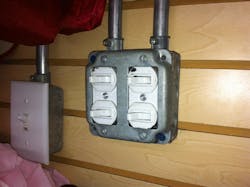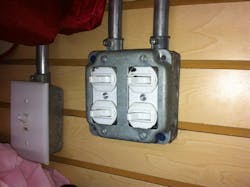What’s Wrong Here? Hint: A Round Peg in a Square Hole
How well do you know the Code? Think you can spot violations the original installer either ignored or couldn't identify? Here's your chance to moonlight as an electrical inspector and second-guess someone else's work from the safety of your living room or office. It's your turn to identify the violation.
Hint: Round peg in square hole
Find the Answer
Well, I suppose I should give an "A" for creative effort here. This installer at least tried to make this safe, but came up a little short in the Code compliance department.
The GFCI style cover is a mismatch with the duplex style switch devices. This would be a violation of 110.3(B) of the 2011 NEC because this cover is not designed to be used with these devices. This arrangement also violates 404.9(A) because it leaves some big gaps between the edges of the device and the cover, which could allow sparks to escape in the event of a short circuit or ground fault in this box. Faceplates must completely cover any openings.
If you look closely, you can also see that the mounting screws used to mount the cover to the box are not the correct type. They appear to be a type of concrete screw instead of an 8/32 machine thread screw. The use of the incorrect screws could cause the cover to become loose, which, in turn, could result in a loss of the required grounding/bonding connection between the box and the cover. Section 250.8(A)(5) requires no less than two machine screw threads to be engaged into the enclosure to establish a good grounding/bonding connection.
About the Author

Russ LeBlanc
Owner
Russ started in the electrical trade as an apprentice in 1985. He worked his way up to become a Journeyman Electrician and then eventually became a Master Electrician and Licensed Construction Supervisor. In 1999 Russ become an Electrical Instructor for The Peterson School of Engineering in Massachusetts where he developed his passion for teaching, and quickly became Department Head of Electrical Instruction. Russ has taught thousands of apprentices, electricians, engineers, inspectors, and other electrical professionals during his career as an instructor. He continues to provide electrical professionals with Electrical Code seminars, Arc-Flash Awareness training seminars and educational material through his LeBlanc Consulting Services in North Reading, MA whose specialty is educating electricians. He has been an active member of the NFPA Electrical Section and has authored hundreds of National Electrical Code proposals and comments which have become Code rules to improve the safety for the electrical industry. Russ is also an IAEI certified Electrical Inspector.
Please visit www.russleblanc.net for more information.

